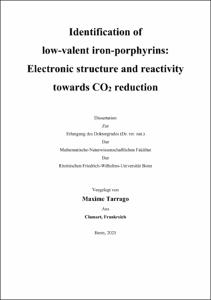Identification of low-valent iron-porphyrins: Electronic structure and reactivity towards CO2 reduction

Identification of low-valent iron-porphyrins: Electronic structure and reactivity towards CO2 reduction

| dc.contributor.advisor | Neese, Frank | |
| dc.contributor.author | Tarrago, Maxime | |
| dc.date.accessioned | 2022-01-25T14:38:02Z | |
| dc.date.available | 2022-01-25T14:38:02Z | |
| dc.date.issued | 25.01.2022 | |
| dc.identifier.uri | https://hdl.handle.net/20.500.11811/9570 | |
| dc.description.abstract | The need to close the carbon cycle becomes urgent as concentration of CO2 in the earth atmosphere increases exponentially. Electrochemically-mediated conversion of CO2 into biofuels is a possible solution to this problem, as it enables storage of energy while using the harmful CO2 feedstock as starting material. Notably, low-valent iron-porphyrins have been established as the best and most selective family of homogeneous catalysts for CO2 reduction into CO, a first step towards the synthesis of biofuel from CO2. The purpose of this research project is to correlate the high activity of [Fe(TPP)] (TPP=tetraphenylporphyrin) towards CO2 reduction with its peculiar electronic structure. With this knowledge in mind, a guideline for the synthesis of efficient and selective catalysts is proposed. To realize this purpose, we investigated the electronic structure of [Fe(TPP)], [Fe(TPP)]- and [Fe(TPP)]2- using a combination of theoretical chemistry coupled with experimental spectroscopic techniques, such as 57Fe Mössbauer, magnetometry measurements and X-ray absorption spectroscopy. After unambiguously determining the electronic structure of each of these species, a reactivity study was carried out to establish the correlation between electronic structure and reactivity. Our results indicate that [Fe(TPP)] is a triplet iron(II) ground state with a quite unique almost three-fold orbital degeneracy of the dxz, dyz and dz2 orbitals. This peculiar electronic structure leads to a large, unquenched orbital angular momentum lying on the porphyrin plane, as observed experimentally. Comparing spectroscopic data of [Fe(TPP)]- and [Fe(TPP)]2- to that of [Fe(TPP)] led to the conclusion that the oxidation state of iron remains unchanged upon one- and two-electrons reduction of [Fe(TPP)]. In other terms, [Fe(TPP)]- and [Fe(TPP)]2- are best described as Fe(II) centers antiferromagnetically coupled with a porphyrin ligand radical and diradical, respectively. In fact, our reactivity study shows how the non-innocent porphyrin ligand in [Fe(TPP)]2- plays a major role in the high reactivity of the complex towards CO2 reduction, by acting as an electron reservoir able to transfer electrons to the CO2 molecule via the metal center. We stress that ligand non-innocence is a common feature in CO2 reduction catalysts, but its role relative to catalytic activity has not yet received sufficient attention. | en |
| dc.language.iso | eng | |
| dc.rights | In Copyright | |
| dc.rights.uri | http://rightsstatements.org/vocab/InC/1.0/ | |
| dc.subject.ddc | 530 Physik | |
| dc.subject.ddc | 540 Chemie | |
| dc.title | Identification of low-valent iron-porphyrins: Electronic structure and reactivity towards CO2 reduction | |
| dc.type | Dissertation oder Habilitation | |
| dc.publisher.name | Universitäts- und Landesbibliothek Bonn | |
| dc.publisher.location | Bonn | |
| dc.rights.accessRights | openAccess | |
| dc.identifier.urn | https://nbn-resolving.org/urn:nbn:de:hbz:5-65022 | |
| ulbbn.pubtype | Erstveröffentlichung | |
| ulbbn.birthname | Tarrago | |
| ulbbnediss.affiliation.name | Rheinische Friedrich-Wilhelms-Universität Bonn | |
| ulbbnediss.affiliation.location | Bonn | |
| ulbbnediss.thesis.level | Dissertation | |
| ulbbnediss.dissID | 6502 | |
| ulbbnediss.date.accepted | 27.08.2021 | |
| ulbbnediss.institute | Mathematisch-Naturwissenschaftliche Fakultät : Fachgruppe Physik/Astronomie / Physikalisches Institut (PI) | |
| ulbbnediss.fakultaet | Mathematisch-Naturwissenschaftliche Fakultät | |
| dc.contributor.coReferee | Grimme, Stefan | |
| ulbbnediss.contributor.gnd | 1254667113 |
Files in this item
This item appears in the following Collection(s)
-
E-Dissertationen (4398)




